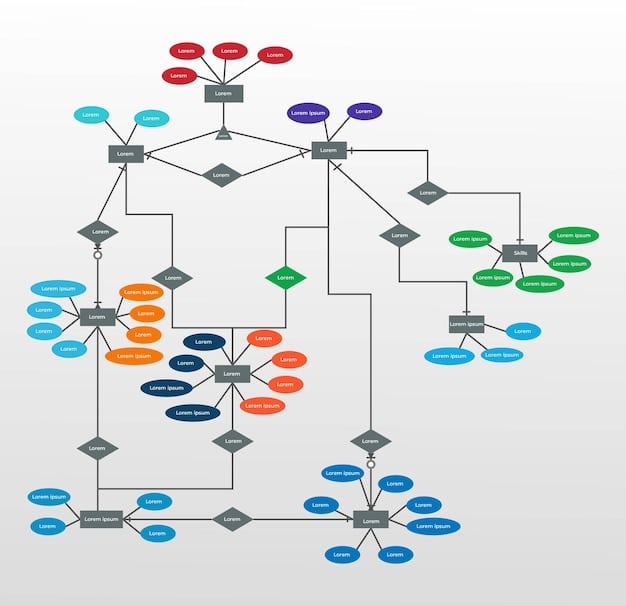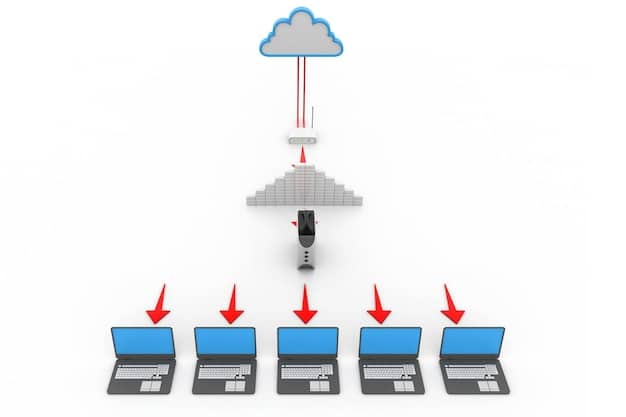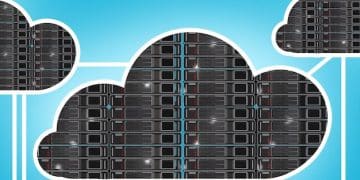Cloud Networking Migration: 7-Step Checklist for US Businesses (2025)

Migrating to cloud networking involves a strategic, multi-step process to ensure a smooth transition for US businesses, encompassing assessment, planning, security, migration, testing, optimization, and ongoing management, all crucial for success in 2025.
Is your US business planning a move to the cloud in 2025? A successful transition to cloud networking requires careful planning and execution. This article provides a 7-step checklist to guide your business through a seamless and secure **migrating to cloud networking** journey.
Cloud Networking Migration: Why Now for US Businesses?
The year 2025 is rapidly approaching, and for US businesses, the imperative to adopt cloud networking is becoming increasingly clear. But why is this transition so vital, and what are the key drivers behind it?
Understanding the urgency and benefits of cloud networking is the first step toward a successful migration.
The Shifting IT Landscape
The IT landscape is constantly evolving, with trends like remote work, IoT, and data analytics demanding more flexible and scalable network solutions. Legacy infrastructure simply can’t keep up.
- Remote Work Revolution: Cloud networking enables secure and reliable access to resources from anywhere, supporting a distributed workforce.
- IoT Explosion: Handling the massive data influx from IoT devices requires the scalability and processing power of cloud-based networks.
- Data-Driven Insights: Cloud networking facilitates the efficient collection, storage, and analysis of large datasets for business intelligence.
Cost Savings and Efficiency
One of the most compelling reasons for migrating to cloud networking is the potential for significant cost savings and improved operational efficiency.
- Reduced Capital Expenditure: Eliminate the need for expensive hardware investments and ongoing maintenance costs.
- Pay-as-you-go Model: Only pay for the resources you consume, optimizing IT spending and reducing waste.
- Automation and Streamlining: Automate network management tasks, freeing up IT staff to focus on strategic initiatives.
Migrating to cloud networking is no longer just a technological upgrade; it’s a strategic move that can unlock significant competitive advantages. As 2025 approaches, US businesses need to prepare for this transformation to stay ahead.
Step 1: Comprehensive Assessment of Current Infrastructure
Before embarking on a cloud networking migration, it’s crucial to have a clear understanding of your existing IT infrastructure. This assessment will serve as the foundation for your migration strategy.
A comprehensive assessment involves a detailed analysis of your current network, applications, data, and security posture.
Network Infrastructure Analysis
Evaluate your existing network hardware, software, and configurations to identify potential bottlenecks and compatibility issues.
This includes:
- Network Inventory: Document all network devices, including routers, switches, firewalls, and servers.
- Bandwidth Analysis: Assess network bandwidth usage to determine current and future requirements.
- Performance Monitoring: Identify performance bottlenecks and areas for improvement.
Application and Data Inventory
Catalog all applications and data sources that will be migrated to the cloud, and assess their dependencies and compatibility.

Essential considerations include:
- Application Dependencies: Identify dependencies between applications and ensure they are compatible with the cloud environment.
- Data Sensitivity: Classify data based on sensitivity and compliance requirements.
- Data Migration Strategy: Develop a plan for migrating data to the cloud, considering factors such as size, format, and transfer speed.
By conducting a thorough assessment, you can gain valuable insights into your current IT environment and identify potential challenges before they impact your migration.
Step 2: Defining Clear Business Objectives and KPIs
Migrating to cloud networking should be driven by clear business objectives and measurable key performance indicators (KPIs). These objectives will guide your migration strategy and ensure that the project delivers tangible business value.
Defining clear objectives and KPIs will help you stay focused and track progress throughout the migration process.
Aligning with Business Goals
Ensure that your cloud networking migration aligns with your broader business goals, such as increased agility, reduced costs, or improved customer experience.
Consider how cloud networking can help you:
- Launch new products and services faster
- Improve operational efficiency
- Enhance customer engagement
Establishing Measurable KPIs
Identify specific, measurable, achievable, relevant, and time-bound (SMART) KPIs to track the success of your cloud networking migration.
Examples of relevant KPIs include:
- Network uptime
- Application performance
- Cost savings
- Customer satisfaction
By establishing clear business objectives and KPIs, you can ensure that your cloud networking migration delivers real value to your organization and contributes to your overall success.
Step 3: Selecting the Right Cloud Networking Model and Provider
Choosing the right cloud networking model and provider is a critical decision that will impact the success of your migration. Different models and providers offer varying levels of control, flexibility, and cost.
Carefully evaluate your options to determine the best fit for your business needs.
Cloud Networking Models: IaaS, PaaS, and SaaS
Understand the different cloud networking models and how they align with your specific requirements.
- Infrastructure as a Service (IaaS): Provides access to virtualized computing resources, allowing you to build and manage your own network infrastructure in the cloud.
- Platform as a Service (PaaS): Offers a platform for developing, running, and managing applications without the complexity of managing underlying infrastructure.
- Software as a Service (SaaS): Delivers ready-to-use applications over the internet, eliminating the need for local installation and maintenance.
Evaluating Cloud Networking Providers
Research and compare different cloud networking providers to find one that meets your technical, business, and security requirements.
Key factors to consider include:
- Service Level Agreements (SLAs): Evaluate the provider’s uptime guarantees, performance metrics, and support commitments.
- Security and Compliance: Ensure the provider has robust security measures in place and complies with relevant industry regulations.
- Pricing and Billing: Understand the provider’s pricing model and billing practices to avoid unexpected costs.
Selecting the right cloud networking model and provider is a crucial step in ensuring a successful and cost-effective migration.
Step 4: Developing a Detailed Migration Plan
A well-defined migration plan is essential for a smooth and successful transition to cloud networking. This plan should outline the specific steps, timelines, and resources required to migrate your applications, data, and network infrastructure to the cloud.
A comprehensive migration plan will help you minimize disruption and ensure a seamless transition.
Phased Migration Approach
Consider a phased migration approach, migrating applications and services in stages to minimize risk and disruption.

This may involve:
- Pilot Migration: Migrate a small subset of applications and services to the cloud to test your migration plan and identify potential issues.
- Parallel Migration: Run your existing and cloud environments in parallel for a period of time to ensure a smooth transition.
- Big Bang Migration: Migrate all applications and services to the cloud at once, which can be riskier but faster.
Data Migration Strategy
Develop a detailed plan for migrating your data to the cloud, considering factors such as data volume, format, and security requirements.
Important considerations include:
- Data Transfer Methods: Choose the appropriate data transfer methods, such as online transfer, offline transfer, or hybrid approaches.
- Data Encryption: Encrypt data during transit and at rest to protect it from unauthorized access.
- Data Validation: Validate data after migration to ensure its integrity and completeness.
A detailed migration plan will provide a roadmap for your cloud networking journey, minimizing risks and ensuring a successful outcome. By focusing on realistic timelines and phased approach, you ensure business continuity with limited impact.
Step 5: Implementing Robust Security Measures
Security is paramount when migrating to cloud networking. Implementing robust security measures is essential to protect your data, applications, and network infrastructure from cyber threats.
A layered security approach will help you mitigate risks and ensure compliance with industry regulations.
Network Security Controls
Implement network security controls to protect your cloud environment from unauthorized access and malicious attacks.
This includes:
- Firewalls: Use firewalls to filter network traffic and block malicious connections.
- Intrusion Detection and Prevention Systems (IDS/IPS): Deploy IDS/IPS to detect and prevent network intrusions.
- Virtual Private Networks (VPNs): Use VPNs to create secure connections between your on-premises network and the cloud.
Data Security and Compliance
Implement data security measures to protect sensitive data and ensure compliance with regulations such as GDPR and HIPAA.
Key considerations include:
- Data Encryption: Encrypt data at rest and in transit to protect it from unauthorized access.
- Access Control: Implement strict access control policies to limit access to sensitive data.
- Data Loss Prevention (DLP): Deploy DLP solutions to prevent sensitive data from leaving your control.
By implementing robust security measures, you can protect your organization from cyber threats and ensure the confidentiality, integrity, and availability of your data in the cloud.
Step 6: Testing and Optimization
After migrating to cloud networking, thorough testing and optimization are crucial to ensure that your applications and network infrastructure are performing optimally.
Continuous monitoring and optimization will help you identify and resolve performance issues and improve overall efficiency.
Performance Testing
Conduct performance testing to identify bottlenecks and optimize application performance in the cloud environment.
This includes:
- Load Testing: Simulate real-world user traffic to assess the performance of your applications under load.
- Stress Testing: Push your applications to their limits to identify breaking points and ensure resilience.
- Latency Testing: Measure network latency to identify areas for improvement.
Resource Optimization
Optimize resource utilization to reduce costs and improve overall efficiency.
Consider:
- Right-Sizing Instances: Choose the appropriate instance sizes for your applications based on their resource requirements.
- Auto-Scaling: Implement auto-scaling to dynamically adjust resources based on demand.
- Storage Optimization: Optimize storage utilization by identifying and deleting unused data.
Through continuous testing and optimization, you can ensure that your cloud networking environment is performing at its best, delivering maximum value to your organization.
Step 7: Ongoing Management and Monitoring
Migrating to cloud networking is not a one-time event; it requires ongoing management and monitoring to ensure continued success. Establishing a robust monitoring and management framework will help you proactively identify and resolve issues, optimize performance, and maintain security.
Continuous monitoring and management are essential for ensuring the long-term success of your cloud networking environment.
Network Monitoring
Implement network monitoring tools to track network performance, identify anomalies, and troubleshoot issues.
This includes:
- Real-Time Monitoring: Monitor network traffic, bandwidth utilization, and device health in real time.
- Alerting and Notifications: Configure alerts to notify you of critical events and potential issues.
- Log Analysis: Analyze network logs to identify security threats and performance bottlenecks.
Cost Management
Implement cost management tools to track cloud spending, identify areas for optimization, and avoid unexpected costs.
Consider:
- Cost Visibility: Gain visibility into your cloud spending by tracking resource utilization and costs.
- Budgeting and Forecasting: Set budgets and forecast future cloud spending to stay within your financial constraints.
- Cost Optimization Recommendations: Receive recommendations for optimizing cloud spending based on your usage patterns.
By establishing a comprehensive monitoring and management framework, you can ensure that your cloud networking environment remains secure, efficient, and cost-effective over the long term.
| Key Aspect | Brief Description |
|---|---|
| ✔️ Assessment | Evaluate existing infrastructure before migrating. |
| 🎯 Objectives | Define clear business goals and KPIs. |
| ☁️ Model Selection | Choose the right cloud networking model (IaaS, PaaS, SaaS). |
| 🛡️ Security | Implement security measures to protect data. |
Frequently Asked Questions
▼
Migrating to cloud networking offers scalability, cost savings, enhanced security, and improved collaboration. It allows businesses to adapt quickly to changing demands and access resources on demand, optimizing IT spending.
▼
Consider factors such as service level agreements (SLAs), security measures, compliance certifications, pricing models, and customer support. Evaluate providers based on your specific needs and business requirements.
▼
Implement firewalls, intrusion detection systems (IDS), data encryption, access controls, and data loss prevention (DLP) solutions. Regularly audit and update your security measures to protect against evolving threats.
▼
Optimize resource utilization, right-size instances, implement auto-scaling, and monitor cloud spending. Regularly review and adjust your resource allocation to minimize waste and maximize cost efficiency.
▼
The key steps include assessment, planning, model selection, migration, security implementation, testing, and ongoing management. Develop a detailed plan outlining specific steps, timelines, and resources for a smooth transition.
Conclusion
In conclusion, migrating to cloud networking in 2025 presents a wealth of opportunities for US businesses seeking scalability, efficiency, and enhanced security. By following this 7-step checklist, companies can navigate the complexities of cloud migration with confidence, ensuring a smooth transition and realizing the full potential of cloud networking for future growth and success.





